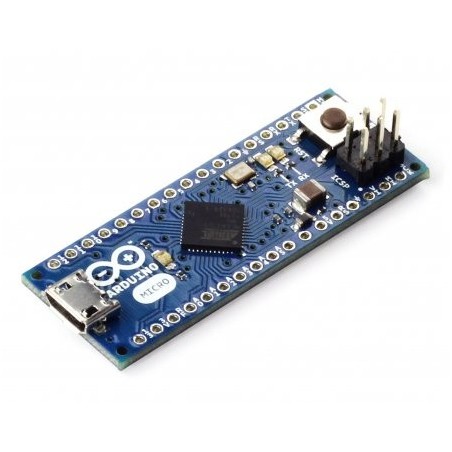







It has 20 digital input/output pins (of which 7 can be used as PWM outputs and 12 as analog inputs), a 16 MHz crystal oscillator, a micro USB connection, an ICSP header and a reset button.
The Arduino Micro is a microcontroller board based on the ATmega32u4, developed in conjunction with Adafruit. It has 20 digital input/output pins (of which 7 can be used as PWM outputs and 12 as analog inputs), a 16 MHz crystal oscillator, a micro USB connection, an ICSP header and a reset button. It contains everything needed to support the microcontroller; simply connect it to a computer with a micro USB cable to get started. It has a form factor that enables it to be easily placed on a breadboard.
The Micro is similar to the Arduino Leonardo in that the ATmega32u4 has built-in USB communication, eliminating the need for a secondary processor. This allows the Micro to appear to a connected computer as a mouse and keyboard, in addition to a virtual (CDC) serial / COM port. It also has other implications for the behavior of the board.
| Microcontroller | ATmega32u4 |
| Operating Voltage | 5V |
| Input Voltage (recommended) | 7-12V |
| Input Voltage (limit) | 6-20V |
| Digital I/O Pins | 20 |
| PWM Digital I/O Pins | 7 |
| Analog Input Pins | 12 |
| DC Current per I/O Pin | 40 |
| DC Current for 3.3V Pin | 50 |
| Flash Memory | 32 kB |
| Flash Memory for Bootloader | 4 kB |
| SRAM | 2.5 kB |
| EEPROM | 1 kB |
| Clock Speed | 16 MHz |
| Lenght | 48 mm |
| Width |
18 mm |

It has 20 digital input/output pins (of which 7 can be used as PWM outputs and 12 as analog inputs), a 16 MHz crystal oscillator, a micro USB connection, an ICSP header and a reset button.
